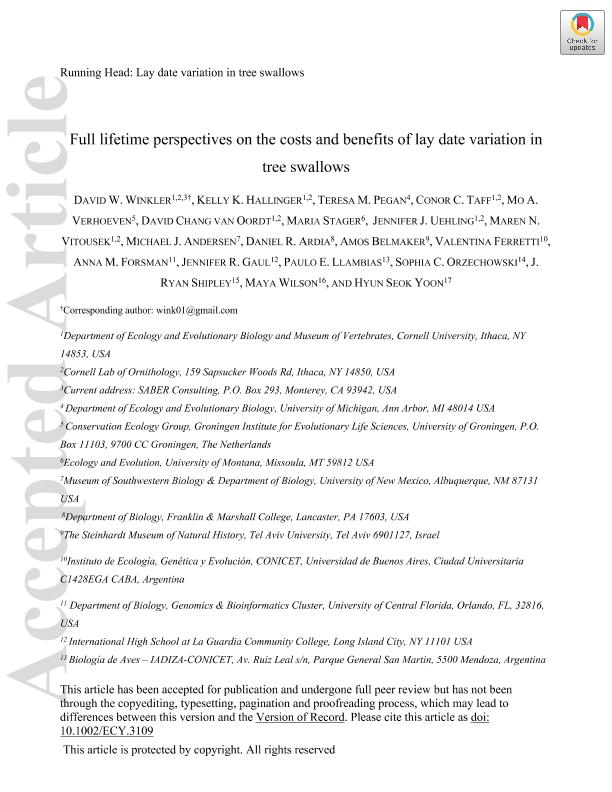Artículo
Full lifetime perspectives on the costs and benefits of lay date variation in tree swallows
Winkler, David Ward; Hallinger, Kelly K.; Pegan, Teresa M.; Taff, Conor C.; Verhoeven, Mo A.; Van Oordt, David Chang; Stager, Maria; Uehling, Jennifer J.; Vitousek, Maren N.; Andersen, Michael J.; Ardia, Daniel R.; Belmaker, Amos; Ferretti, Valentina ; Forsman, Anna M.; Gaul, Jennifer R.; Llambias, Paulo
; Forsman, Anna M.; Gaul, Jennifer R.; Llambias, Paulo ; Orzechowski, Sophia C.; Shipley, Ryan; Wilson, Maya; Yoon, Hyun Seok
; Orzechowski, Sophia C.; Shipley, Ryan; Wilson, Maya; Yoon, Hyun Seok
 ; Forsman, Anna M.; Gaul, Jennifer R.; Llambias, Paulo
; Forsman, Anna M.; Gaul, Jennifer R.; Llambias, Paulo ; Orzechowski, Sophia C.; Shipley, Ryan; Wilson, Maya; Yoon, Hyun Seok
; Orzechowski, Sophia C.; Shipley, Ryan; Wilson, Maya; Yoon, Hyun Seok
Fecha de publicación:
05/2020
Editorial:
Ecological Society of America
Revista:
Ecology
ISSN:
0012-9658
Idioma:
Inglés
Tipo de recurso:
Artículo publicado
Clasificación temática:
Resumen
Animals must balance various costs and benefits when deciding when to breed. The costs and benefits of breeding at different times have received much attention, but most studies have been limited to investigating short-term season-to-season fitness effects. However, breeding early, versus late, in a season may influence lifetime fitness over many years, trading off in complex ways across the breeder?s lifepan. In this study, we examined the complete life histories of 867 female tree swallows (Tachycineta bicolor) breeding in Ithaca, New York, between 2002 and 2016. Earlier breeders outperformed later breeders in short-term measures of reproductive output and offspring quality. Though there were weak indications that females paid long-term future survival costs for breeding early, lifetime fledgling output was markedly higher overall in early-breeding birds. Importantly, older females breeding later in the season did not experience compensating life-history advantages that suggested an alternative equal-fitness breeding strategy. Rather, most or all of the swallows appear to be breeding as early as they can, and differences in lay dates appear to be determined primarily by differences in individual quality or condition. Lay date had a significant repeatability across breeding attempts by the same female, and the first lay date of females fledged in our population was strongly influenced by the first lay date of their mothers, indicating the potential for ongoing selection on lay date. By examining performance over the entire lifespan of a large number of individuals, we were able to clarify the relationship between timing of breeding and fitness and gain new insight into the sources of variability in this important life history trait.
Archivos asociados
Licencia
Identificadores
Colecciones
Articulos(IADIZA)
Articulos de INST. ARG DE INVEST. DE LAS ZONAS ARIDAS
Articulos de INST. ARG DE INVEST. DE LAS ZONAS ARIDAS
Citación
Winkler, David Ward; Hallinger, Kelly K.; Pegan, Teresa M.; Taff, Conor C.; Verhoeven, Mo A.; et al.; Full lifetime perspectives on the costs and benefits of lay date variation in tree swallows; Ecological Society of America; Ecology; 101; 9; 5-2020; 1-49
Compartir
Altmétricas



